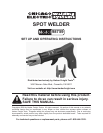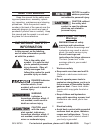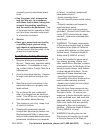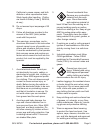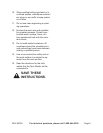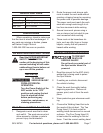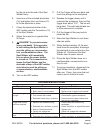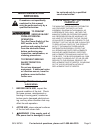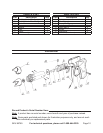SKU 98759 For technical questions, please call 1-800-444-3353. Page 3
Do not expose power tools to rain b.
or wet conditions. Water entering
a power tool will increase the risk of
electric shock.
Do not abuse the cord. Never use c.
the cord for carrying, pulling or
unplugging the power tool. Keep
cord away from heat, oil, sharp
edges or moving parts. Damaged
or entangled cords increase the risk
of electric shock.
When operating a power tool out-d.
doors, use an extension cord suit-
able for outdoor use. Use of a cord
suitable for outdoor use reduces the
risk of electric shock.
If operating a power tool in a damp e.
location is unavoidable, use a
Ground Fault Circuit Interrupter
(GFCI) protected supply. Use of
a GFCI reduces the risk of electric
shock.
Personal safety3.
Stay alert, watch what you are do-a.
ing and use common sense when
operating a power tool. Do not use
a power tool while you are tired
or under the inuence of drugs,
alcohol or medication. A moment
of inattention while operating power
tools may result in serious personal
injury.
Use personal protective equip-b.
ment. Always wear eye protection.
Safety equipment such as welding
mask, non-skid safety shoes, and
welding apron used for appropriate
conditions will reduce personal inju-
ries.
Prevent unintentional starting. En-c.
sure the switch of the stick welder
is in the off-position before con-
necting to power source, picking
up or carrying the tool.
Do not overreach. Keep proper d.
footing and balance at all times.
This enables better control of the
power tool in unexpected situations.
Dress properly. Do not wear loose e.
clothing or jewelry. Keep your
hair, clothing and gloves away
from moving parts. Loose clothes,
jewelry or long hair can be caught in
moving parts.
Only use safety equipment that f.
has been approved by an appropri-
ate standards agency. Unapproved
safety equipment may not provide
adequate protection. Eye protection
must be ANSI-approved and breath-
ing protection must be NIOSH-ap-
proved for the specic hazards in the
work area.
Power tool use and care4.
Do not force the power tool. Use a.
the correct power tool for your ap-
plication. The correct power tool will
do the job better and safer at the rate
for which it was designed.
Store idle power tools out of the b.
reach of children and do not allow
persons unfamiliar with the power
tool or these instructions to oper-
ate the power tool. Power tools are
dangerous in the hands of untrained
users.
Maintain power tools. Check for c.
misalignment or binding of moving
parts, breakage of parts and any
other condition that may affect the
power tool’s operation. If dam-
aged, have the power tool repaired
before use. Many accidents are



